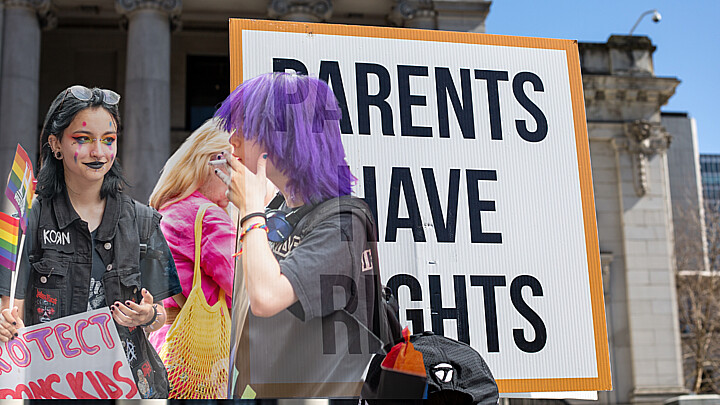Health
Hispanic cities in U.S. targeted with fentanyl, Latino fatality rate near tripled since 2011
Deadly overdoses among the Hispanic community from opioids mixed with cocaine rose 729%, and when mixed with methamphetamines, rose 4,600%

March 24, 2023 9:20am
Updated: March 25, 2023 11:01am
As U.S. officials continue to wage war against the opioid crisis, and the media shines a light on many of the victims in affluent suburban communities, the number of Latino fatalities that can be attributed to fentanyl have escalated.
Experts say the use of the drug is primarily combined with other narcotics, and in many instances, the users are unaware fentanyl is being used because it is a cheaper alternative that creates a higher margin for drug dealers.
Latino fentanyl fatalities have nearly tripled since 2011
Overdose fatalities among Latinos have nearly tripled since 2011, according to a study published March 1, 2022 in the American Journal of Epidemiology.
“In the United States, combined stimulant/opioid overdose mortality has risen dramatically over the last decade. These increases may particularly affect non-Hispanic Black and Hispanic populations,” the report says.
People died from overdoses more frequently when fentanyl is combined with other drugs, like cocaine and methamphetamines, the study says, many of which are more common among Latinos than heroin or prescription painkillers, which are popular among affluent white communities, some experts suggest.
“Growing contamination of nonopioid drugs by illicitly manufactured fentanyl, an extremely potent synthetic opioid, is largely responsible for the increase in stimulant/opioid overdose mortality. People who use drugs may be unaware of fentanyl’s presence in their stimulant supply, increasing the risk of overdose,” the study said.
One of the study’s co-authors echoed that sentiment in an interview with NBC Latino.
According to Magdalena Cerdá, professor and director at the Center for Opioid Epidemiology and Policy at NYU Langone, between 2007 and 2019, deadly overdoses among the Hispanic community from opioids mixed with cocaine rose 729%, and when mixed with methamphetamines, rose 4,600%.
“There is a lot of product in all drugs at the moment, except for cannabis, which is contaminated with fentanyl,” Cerdá told NBC Latino.
The NBC report acknowledged that although it is not entirely clear how often the dealers are intentionally mixing fentanyl with their product, evidence suggests the deadly mixtures are happening frequently.
“It’s not clear if this mix happens on purpose or by accident, but researchers believe both are happening, according to Cerdá. Fentanyl is highly addictive, so some dealers may be mixing it with other drugs to make their clients more dependent. On the other hand, there are those who do consume fentanyl intentionally because they have developed a tolerance to opioids and need increasingly higher doses,” the report says.
Hispanic American cities targeted
Washington Post investigative reporter Scott Higham, author of “American Cartel: Inside the battle to bring down the opioid industry,” which indicates that Hispanics are at greater risk because they represent a larger part of the population in major cities, such as Los Angeles, Miami, New York and San Diego where the drug is being distributed.
Though Hispanics usually have a lower overdose rates compared to Whites, “you see it’s increasing, so it’s really worrying,” Cerdá told NBC Latino.
The opioid crisis had reported got worse in 2020 amid the COVID-19 pandemic, a time when overdose fatalities rose and Hispanics were impacted.
“In June 2021, the Nevada Department of Health and Human Services reported an increase in drug overdose deaths during 2020 among Hispanic or Latino (Hispanic) persons, who make up approximately one third of Nevada’s population,” according to a May 13, 2022 report published by the Centers for Disease Control.
That report says that while overdose fatalities increased overall by 54.5% from 2019 to 2020, it escalated by 119.7% among Hispanics.
“Latinos represent only 8.6% of rural areas and 19.8% of urban areas, according to data from the Department of Agriculture, but they are the fastest-growing segment of the rural population,” according to the NBC Latino report.
Fentanyl is flowing from Mexican drug cartels and communist China
Mexican President Andrés Manuel Lopez Obrador recently insisted on March 8 that the drug was not manufactured in his country and that the crisis should be blamed on parents in the U.S. instead, a claim Mexican security experts immediately pushed back on.
“Here, we do not produce fentanyl, and we do not have consumption of fentanyl,” Lopez Obrador said. “Why don’t they (the United States) take care of their problem of social decay?”
Those comments came only about a month after the Mexican government announced one of its largest seizures of the synthetic drug during a raid of a drug lab. During the raid, more than half a million fentanyl pills were found in an outdoor lab in Culiacan, in the Mexican state of Sinaloa.
“The president is lying,” said Mexican security analyst David Saucedo. “The Mexican cartels, above all the CJNG (Jalisco New Generation Cartel) and the Sinaloa Cartel have learned to manufacture it. They themselves buy the precursor chemicals, set up laboratories to produce fentanyl and distribute it to cities in the United States and sell it. Little by little they have begun to build a monopoly on fentanyl because the Mexican cartels are present along the whole chain of production and sales.”
But Mexico isn't the only place manufacturing high amounts of fentanyl.
Much of the current fentanyl flowing into the U.S. is flowing from across the Pacific in communist China, according to Dec. 8, 2022 report published by Congressional Research Services,
“Early in the U.S. opioid epidemic, the People’s Republic of China (PRC, or China) was the primary source of illicit fentanyl,” the CRS report says.
“Direct flows of fentanyl from China are now largely stemmed. U.S. counternarcotics policy with regard to China has shifted to preventing Chinese-sourced fentanyl precursors from entering the U.S. bound fentanyl supply chain via third countries, and targeting illicit fentanyl- related financial flows linked to the PRC. U.S. [and] PRC cooperation on drug control issues has been severely strained since 2020,” the CRS report says.
Republican legislators: Use U.S. military in war against drug cartels
The fentanyl crisis is among the most significant issues concerning U.S. officials about how what's happening south of the U.S. border. That issue along with drug cartel violence has heralded a call from Republican legislators who now believe the drug cartel problem demands military intervention.
“This is a problem of mass poisoning of the citizens of the United States and the cartels are directly responsible,” Rep. Dan Crenshaw, R-Texas, who introduced a bill earlier this year to authorize military force against the cartels.
“My questions to you are the following: Why do you reject aid from the United States? Why do you protect the cartels? They are your enemy and the United States is your friend,” he added.
Sen. Lindsey Graham, R-S.C., said he would introduce legislation re-designate the Mexican drug cartels as foreign terrorist organizations, allowing the U.S. military to take action against them.
“We're going to unleash the fury and might of the United States against these cartels,” Graham said at a press conference.
“We're going to destroy their business model and their lifestyle because our national security and the security of the United States as a whole depends on us taking decisive action.”
Lopez Obrador said the Republican calls for military intervention were “an offense to the people of Mexico,” and said he would never “permit any foreign government to intervene in our territory, much less than a government's armed forces intervene."
Fentanyl has been synthesized since 1959 and was placed under U.N. international control since 1964, according to Congressional Research Services.











